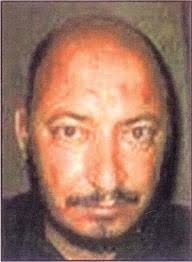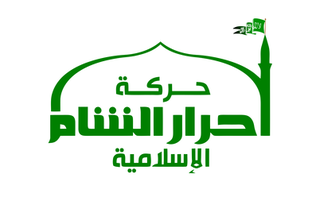
Abu Ayyub al-Masri, also known as Abu Hamza al-Muhajir, born Abdel Moneim Ezz El-Din Ali Al-Badawi, was an Egyptian militant leader who was the leader of Al-Qaeda in Iraq during the Iraqi insurgency, following the death of Abu Musab al-Zarqawi in June 2006. He was war minister of the Islamic State of Iraq from 2006 to 2010 and prime minister of the Islamic State of Iraq from 2009 to 2010. He was killed during a raid on his safehouse on 18 April 2010.

Abu Omar al-Baghdadi, born Hamid Dawud Mohamed Khalil al-Zawi was an Iraqi militant who was the Emir of the Islamic militant umbrella organization Mujahideen Shura Council (MSC), and its successor, the Islamic State of Iraq (ISI), which fought against the U.S.-led Coalition forces during the Iraqi insurgency.

Harakat Ahrar al-Sham al-Islamiyya, commonly referred to as Ahrar al-Sham, is a coalition of multiple Islamist units that coalesced into a single brigade and later a division in order to fight against the Syrian Government led by Bashar al-Assad during the Syrian Civil War. Ahrar al-Sham was led by Hassan Aboud until his death in 2014. In July 2013, Ahrar al-Sham had 10,000 to 20,000 fighters, which at the time made it the second most powerful unit fighting against al-Assad, after the Free Syrian Army. It was the principal organization operating under the umbrella of the Syrian Islamic Front and was a major component of the Islamic Front. With an estimated 20,000 fighters in 2015, Ahrar al-Sham became the largest rebel group in Syria after the Free Syrian Army became less powerful. Ahrar al-Sham and Jaysh al-Islam are the main rebel groups supported by Turkey. On 18 February 2018, Ahrar al-Sham merged with the Nour al-Din al-Zenki Movement to form the Syrian Liberation Front.

The Islamic State of Iraq was a Salafi jihadist militant organization that fought the forces of the U.S.-led coalition during the Iraqi insurgency. The organization aimed to overthrow the Iraqi federal government and establish an Islamic state governed by Sharia law in Iraq.

Taha Sobhi Falaha, better known by his nom de guerreAbu Muhammad al-Adnani al-Shami, was a Syrian militant leader who was the official spokesperson and a senior leader of the Islamic State. He was described as the chief of its external operations. He was the second most senior leader of the Islamic State after its leader Abu Bakr al-Baghdadi. Media reports in August 2016 suggested he was in charge of a special unit, known as the Emni, that was established by IS in 2014 with the double objective of internal policing and executing operations outside IS territory.

Ahmed Hussein al-Sharaa, also known by his nom de guerreAbu Mohammad al-Julani, is a Syrian revolutionary, military commander and politician who has served as the emir of Hay'at Tahrir al-Sham (HTS) since 2017. As the leader of HTS, he played a key role in the 2024 Syrian opposition offensives, which led to the downfall of the Assad regime and establishment of the Syrian transitional government. Since then, al-Sharaa has been widely regarded as Syria's de facto leader.
Thaher Salim Mohammad Al-Shahiri known by his nom de guerre Abul-Hasan al-Muhajir was the kunya used by the second official spokesman of the Islamic State from 5 December 2016 until 27 October 2019, when he was killed in a U.S. airstrike in northwest Syria. He was a Saudi national. He was replaced by Abu Hamza Al-Qurashi.

The Idlib Governorate clashes , were military confrontations between Syrian rebel factions led by Ahrar al-Sham and their allies on one side and the al-Qaeda-aligned Jabhat Fatah al-Sham and their allies on the other. After 7 February, the clashes also included Jund al-Aqsa as a third belligerent, which had re-branded itself as Liwa al-Aqsa and was attacking the other combatants. The battles were fought in the Idlib Governorate and the western countryside of the Aleppo Governorate.

Hay'at Tahrir al-Sham (HTS), also referred to as Tahrir al-Sham, is a Sunni Islamist political and paramilitary organisation involved in the Syrian civil war. It was formed on 28 January 2017 as a merger between several armed factions: Jaysh al-Ahrar, Jabhat Fateh al-Sham (JFS), Ansar al-Din Front, Jaysh al-Sunna, Liwa al-Haqq, and the Nour al-Din al-Zenki Movement. The unification process was held under the initiative of Abu Jaber Shaykh, an Islamist militant commander who had been the second emir of Ahrar al-Sham. HTS, along with other Syrian opposition groups, launched an offensive and toppled the Assad regime on 8 December 2024, and now controls most of the country.

The northwestern Syria campaign was a large-scale military operation that initially started with an offensive conducted by ISIL forces on areas controlled by Tahrir al-Sham (HTS) in the northern Hama Governorate. Subsequently, the Syrian Armed Forces launched their own offensive against HTS and other rebel groups in the area. The campaign took place at the intersection of the provinces of Hama, Idlib and Aleppo.

On 19 February 2018, heavy clashes erupted between the newly established Syrian Liberation Front, which consists of Ahrar al-Sham and the Nour al-Din al-Zenki Movement, backed by the Suqour al-Sham Brigades, and Hayat Tahrir al-Sham (HTS) in the western Aleppo Governorate. The conflict soon spread to the Idlib Governorate and the SLF captured several towns from HTS. A ceasefire between the two groups was reached on 24 April 2018. Fighting again resumed on 1 January 2019, ending with a total HTS military victory on 9 January.

Tanzim Hurras al-Din, sometimes referred to as Al-Qaeda in Syria, is a Salafi Jihadist organization fighting in the Syrian civil war. The group's former head, Abu Humam al-Shami, was the general military commander of the defunct Al-Nusra Front, and had fought for Al-Qaeda during the Third Afghan Civil War and the Iraqi insurgency. Hurras al-Din was established by the leaders of the AQ-affiliated Khorasan group and Al-Qaeda loyalists of Al-Nusra Front who opposed Al-Nusra's dissolution and merger with other Islamic groups to form Tahrir al-Sham. Al-Shami announced the formation of Hurras al-Din on 27 February 2018.
Abu al-Abd Ashidaa is a Syrian rebel commander, Aleppo native, and former head of the Aleppo-based Army of Aleppo rebel coalition that included several Syrian rebel groups including various Free Syrian Army factions as well as Ahrar al-Sham and the Levant Front.

Abu Ibrahim al-Hashimi al-Qurashi was an Iraqi militant and the second caliph of the Islamic State. His appointment by a shura council was announced by the Islamic State media on 31 October 2019, less than a week after the death of previous leader Abu Bakr al-Baghdadi.

The Tahrir al-Sham–Junud al-Sham conflict was a series of violent clashes between Hayat Tahrir al-Sham and several rival jihadist factions operating in the Idlib and Latakia governorates. The clashes began on 25 October 2021 after HTS demanded that the jihadist leader Muslim Abu Walid al Shishani should stand trial after they accused him and his group of sheltering members of the Islamic State.
Abu al-Hasan al-Hashimi al-Qurashi, probably born Nour Karim al-Mutni Al-Obaidi Al-Rifai, was an Iraqi militant and the third caliph of the Islamic State. He was named as caliph on 10 March 2022, in an audio message by the new spokesperson of IS, Abu Umar al-Muhajir, whose announcement came more than a month after the death of his predecessor Abu Ibrahim al-Hashimi al-Qurashi. The message said that Abu al-Hassan was given a pledge of allegiance in response to the will of the former caliph. The Turkish government claimed that he was arrested in Istanbul on 26 May 2022. Later, Islamic State sources denied news reports of his arrest in the 347th issue of their weekly newsletter Al-Naba.
Abu al-Hussein al-Husseini al-Qurashi was the fourth caliph of the Islamic State and allegedly the first Syrian to serve as caliph. He took office on 30 November 2022.
Abu Hudhayfah Al-Ansari is the current spokesman of the Islamic State. He was announced as the spokesman in a speech released by Al-Furqan Foundation media in August 2023. He replaced Abu Omar al-Muhajir as the spokesman of the Islamic State, who was arrested by Tahrir al-Sham.












